Linux Administration Report: Ubuntu Installation and Process Analysis
VerifiedAdded on 2020/03/01
|25
|1916
|427
Report
AI Summary
This report details a student's practical experience with Linux administration, specifically focusing on the Ubuntu 16.04 operating system. The report begins with the selection of Ubuntu as the chosen distribution, justifying its popularity and features. It then outlines the installation process using a virtual machine, detailing the steps taken within VirtualBox, including the creation of a virtual hard disk and the selection of the Ubuntu ISO image. The report also addresses potential problems encountered during installation, like the need for prior Linux knowledge, and provides a timeline of the installation process. Furthermore, the report delves into Linux computer processes, explaining running processes, the init process, kthreadd, and the watchdog function. Shell scripts are also discussed, with examples of commands like 'uptime', 'ss –s' for current connections, 'last' for login details, and 'ps -eo' for CPU consumption. The report concludes with a list of references.
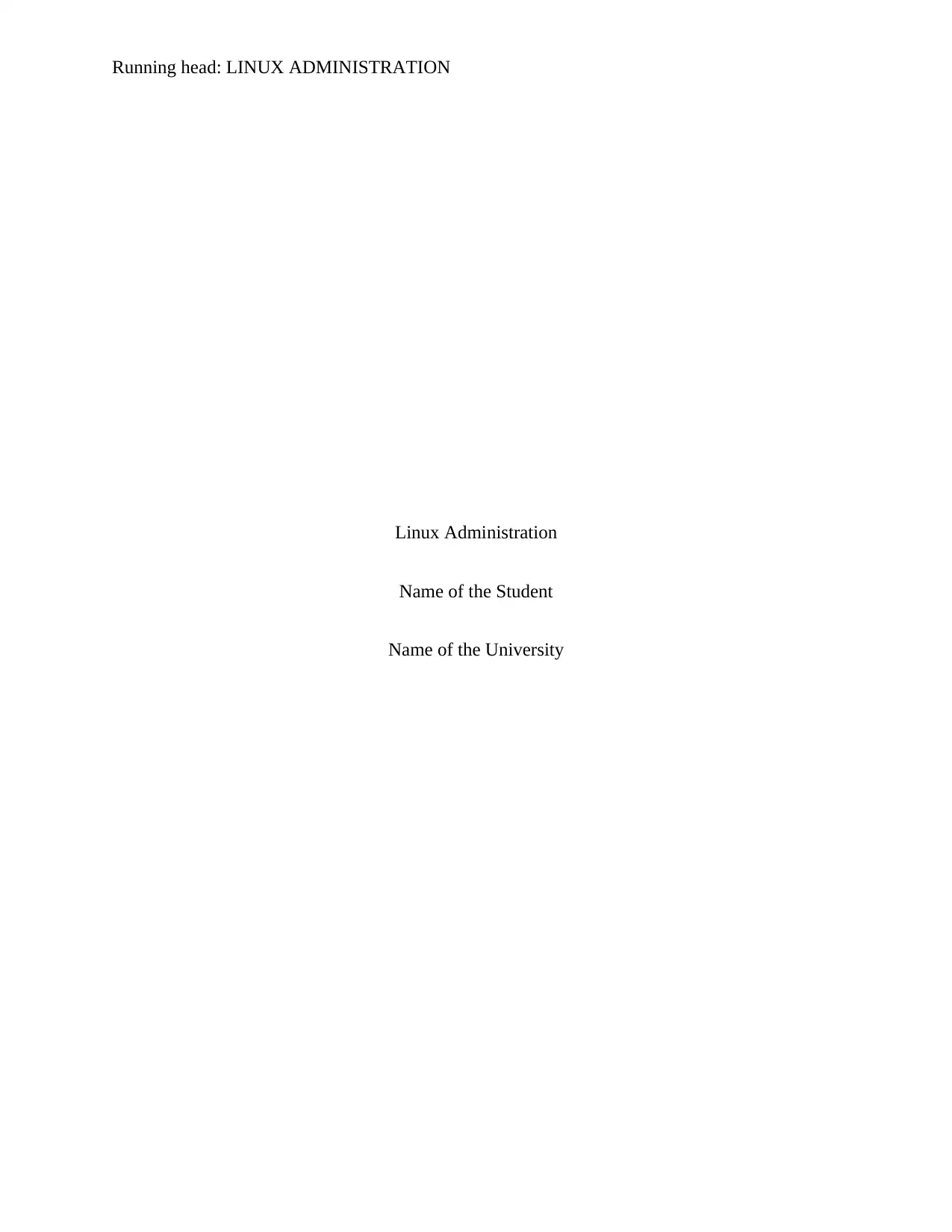
Running head: LINUX ADMINISTRATION
Linux Administration
Name of the Student
Name of the University
Linux Administration
Name of the Student
Name of the University
Paraphrase This Document
Need a fresh take? Get an instant paraphrase of this document with our AI Paraphraser
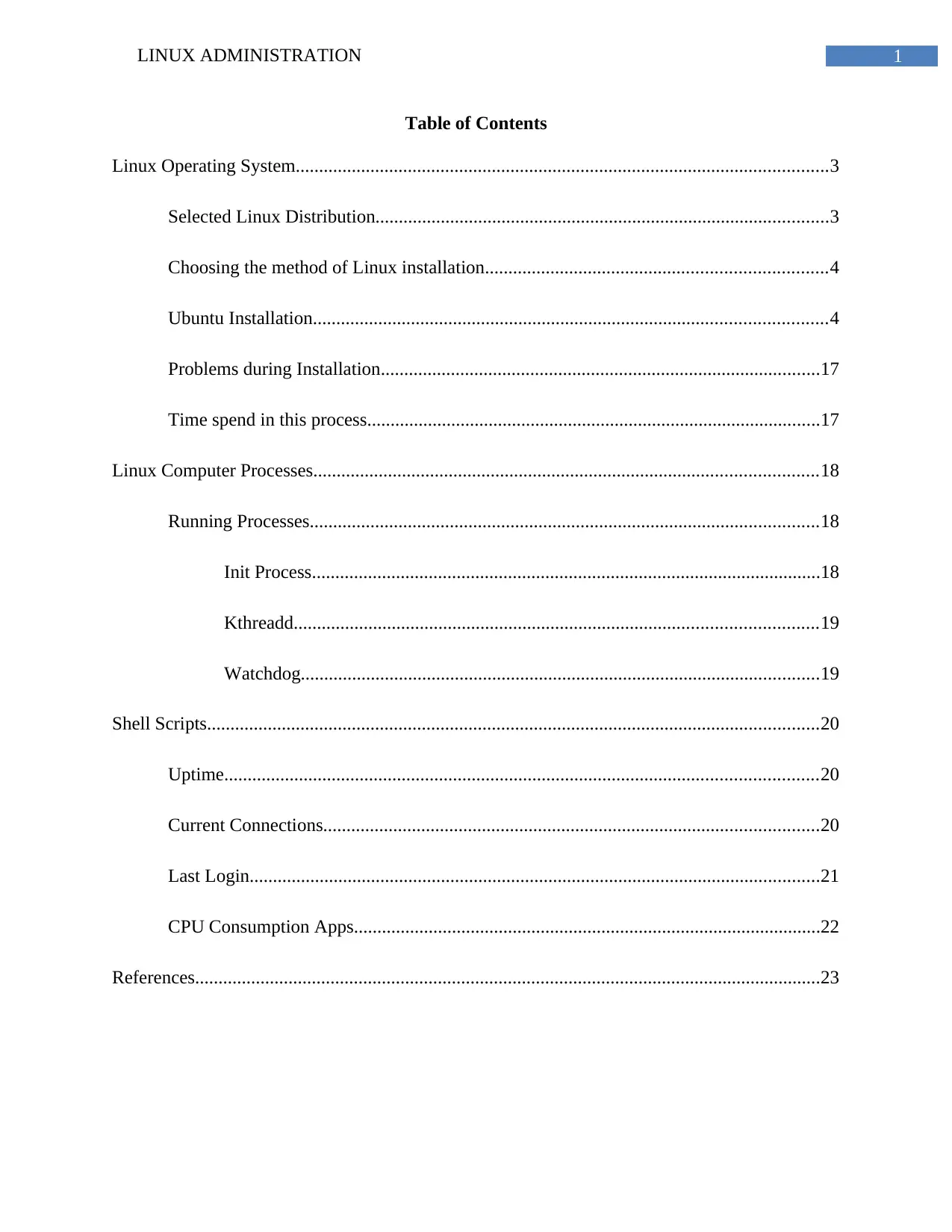
1LINUX ADMINISTRATION
Table of Contents
Linux Operating System..................................................................................................................3
Selected Linux Distribution.................................................................................................3
Choosing the method of Linux installation.........................................................................4
Ubuntu Installation..............................................................................................................4
Problems during Installation..............................................................................................17
Time spend in this process.................................................................................................17
Linux Computer Processes............................................................................................................18
Running Processes.............................................................................................................18
Init Process.............................................................................................................18
Kthreadd................................................................................................................19
Watchdog...............................................................................................................19
Shell Scripts...................................................................................................................................20
Uptime...............................................................................................................................20
Current Connections..........................................................................................................20
Last Login..........................................................................................................................21
CPU Consumption Apps....................................................................................................22
References......................................................................................................................................23
Table of Contents
Linux Operating System..................................................................................................................3
Selected Linux Distribution.................................................................................................3
Choosing the method of Linux installation.........................................................................4
Ubuntu Installation..............................................................................................................4
Problems during Installation..............................................................................................17
Time spend in this process.................................................................................................17
Linux Computer Processes............................................................................................................18
Running Processes.............................................................................................................18
Init Process.............................................................................................................18
Kthreadd................................................................................................................19
Watchdog...............................................................................................................19
Shell Scripts...................................................................................................................................20
Uptime...............................................................................................................................20
Current Connections..........................................................................................................20
Last Login..........................................................................................................................21
CPU Consumption Apps....................................................................................................22
References......................................................................................................................................23

2LINUX ADMINISTRATION
⊘ This is a preview!⊘
Do you want full access?
Subscribe today to unlock all pages.

Trusted by 1+ million students worldwide
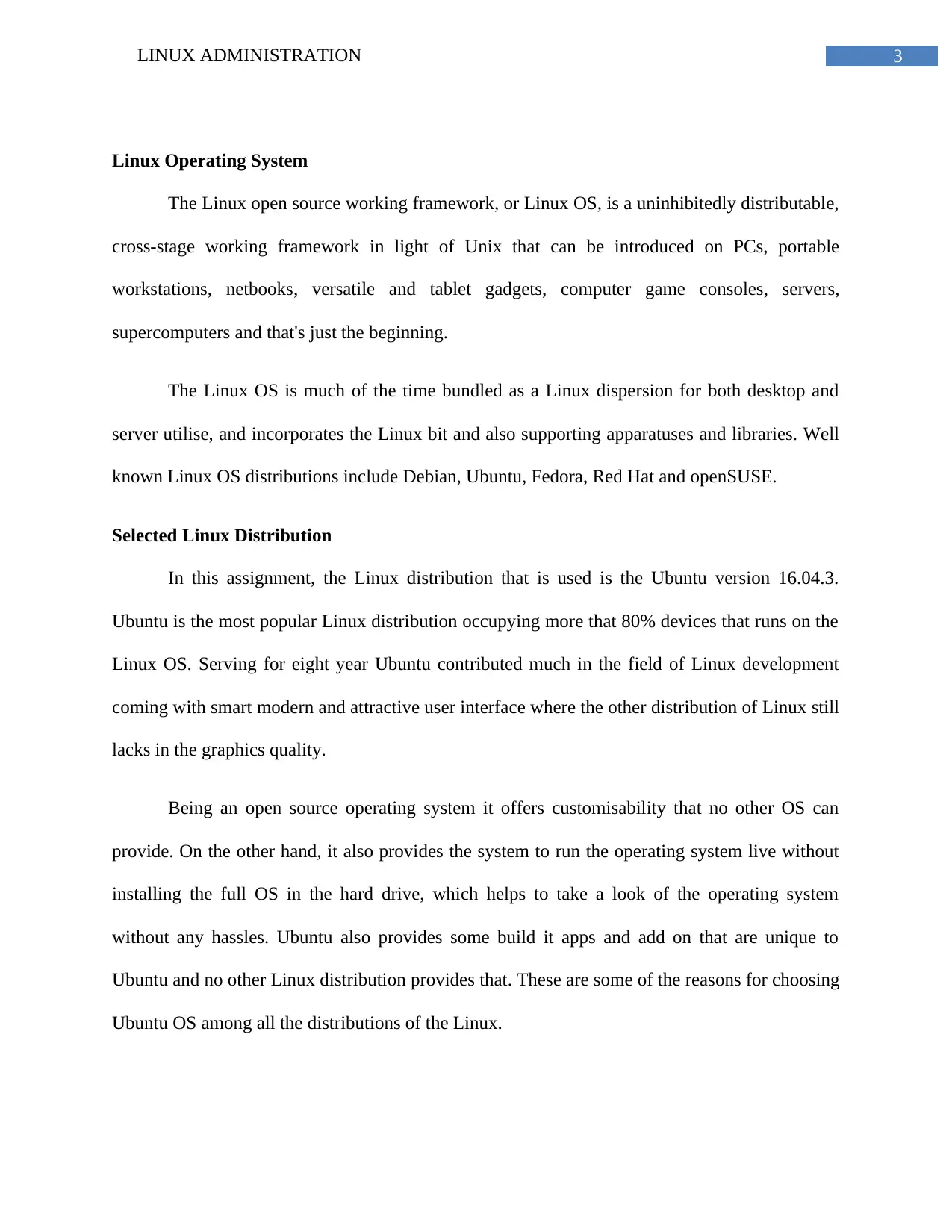
3LINUX ADMINISTRATION
Linux Operating System
The Linux open source working framework, or Linux OS, is a uninhibitedly distributable,
cross-stage working framework in light of Unix that can be introduced on PCs, portable
workstations, netbooks, versatile and tablet gadgets, computer game consoles, servers,
supercomputers and that's just the beginning.
The Linux OS is much of the time bundled as a Linux dispersion for both desktop and
server utilise, and incorporates the Linux bit and also supporting apparatuses and libraries. Well
known Linux OS distributions include Debian, Ubuntu, Fedora, Red Hat and openSUSE.
Selected Linux Distribution
In this assignment, the Linux distribution that is used is the Ubuntu version 16.04.3.
Ubuntu is the most popular Linux distribution occupying more that 80% devices that runs on the
Linux OS. Serving for eight year Ubuntu contributed much in the field of Linux development
coming with smart modern and attractive user interface where the other distribution of Linux still
lacks in the graphics quality.
Being an open source operating system it offers customisability that no other OS can
provide. On the other hand, it also provides the system to run the operating system live without
installing the full OS in the hard drive, which helps to take a look of the operating system
without any hassles. Ubuntu also provides some build it apps and add on that are unique to
Ubuntu and no other Linux distribution provides that. These are some of the reasons for choosing
Ubuntu OS among all the distributions of the Linux.
Linux Operating System
The Linux open source working framework, or Linux OS, is a uninhibitedly distributable,
cross-stage working framework in light of Unix that can be introduced on PCs, portable
workstations, netbooks, versatile and tablet gadgets, computer game consoles, servers,
supercomputers and that's just the beginning.
The Linux OS is much of the time bundled as a Linux dispersion for both desktop and
server utilise, and incorporates the Linux bit and also supporting apparatuses and libraries. Well
known Linux OS distributions include Debian, Ubuntu, Fedora, Red Hat and openSUSE.
Selected Linux Distribution
In this assignment, the Linux distribution that is used is the Ubuntu version 16.04.3.
Ubuntu is the most popular Linux distribution occupying more that 80% devices that runs on the
Linux OS. Serving for eight year Ubuntu contributed much in the field of Linux development
coming with smart modern and attractive user interface where the other distribution of Linux still
lacks in the graphics quality.
Being an open source operating system it offers customisability that no other OS can
provide. On the other hand, it also provides the system to run the operating system live without
installing the full OS in the hard drive, which helps to take a look of the operating system
without any hassles. Ubuntu also provides some build it apps and add on that are unique to
Ubuntu and no other Linux distribution provides that. These are some of the reasons for choosing
Ubuntu OS among all the distributions of the Linux.
Paraphrase This Document
Need a fresh take? Get an instant paraphrase of this document with our AI Paraphraser
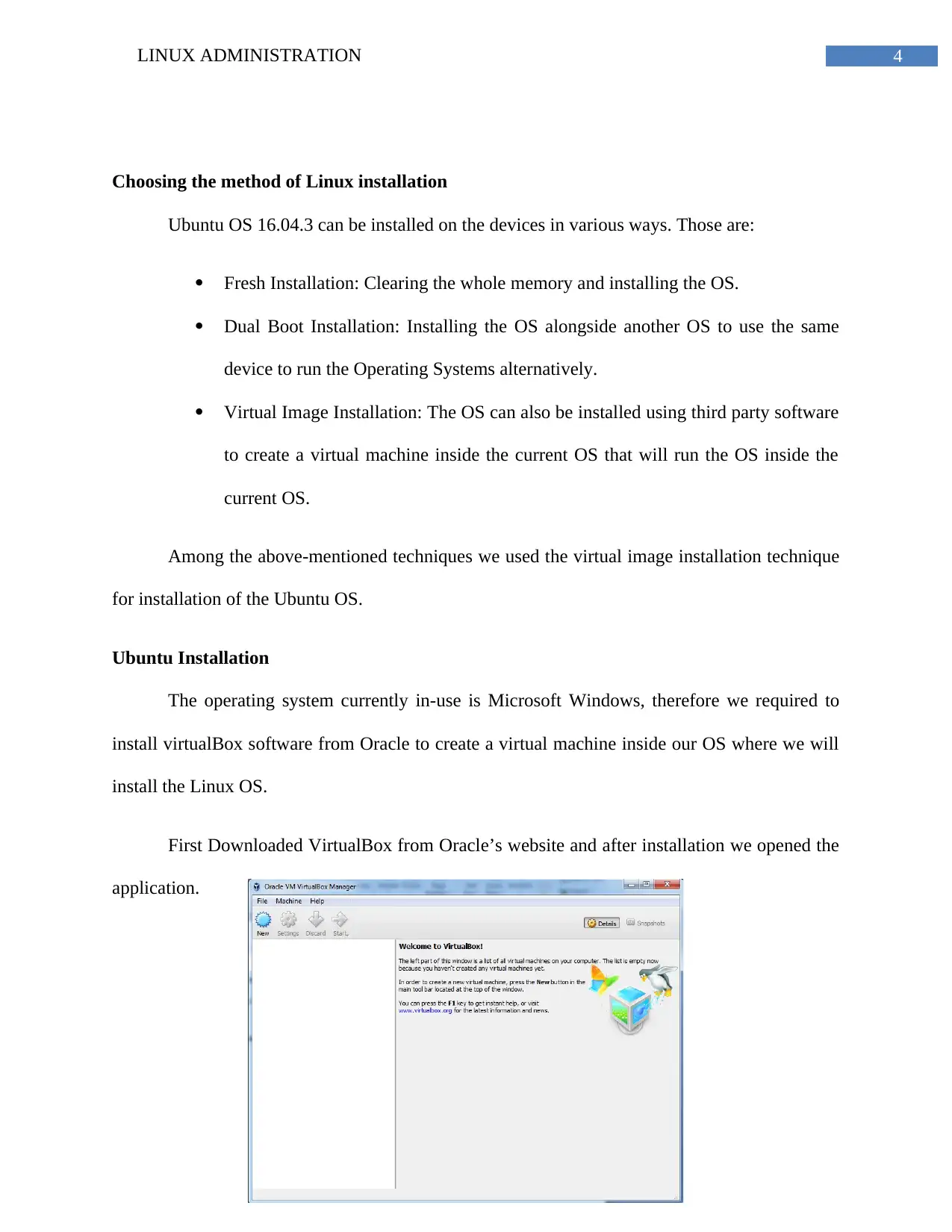
4LINUX ADMINISTRATION
Choosing the method of Linux installation
Ubuntu OS 16.04.3 can be installed on the devices in various ways. Those are:
Fresh Installation: Clearing the whole memory and installing the OS.
Dual Boot Installation: Installing the OS alongside another OS to use the same
device to run the Operating Systems alternatively.
Virtual Image Installation: The OS can also be installed using third party software
to create a virtual machine inside the current OS that will run the OS inside the
current OS.
Among the above-mentioned techniques we used the virtual image installation technique
for installation of the Ubuntu OS.
Ubuntu Installation
The operating system currently in-use is Microsoft Windows, therefore we required to
install virtualBox software from Oracle to create a virtual machine inside our OS where we will
install the Linux OS.
First Downloaded VirtualBox from Oracle’s website and after installation we opened the
application.
Choosing the method of Linux installation
Ubuntu OS 16.04.3 can be installed on the devices in various ways. Those are:
Fresh Installation: Clearing the whole memory and installing the OS.
Dual Boot Installation: Installing the OS alongside another OS to use the same
device to run the Operating Systems alternatively.
Virtual Image Installation: The OS can also be installed using third party software
to create a virtual machine inside the current OS that will run the OS inside the
current OS.
Among the above-mentioned techniques we used the virtual image installation technique
for installation of the Ubuntu OS.
Ubuntu Installation
The operating system currently in-use is Microsoft Windows, therefore we required to
install virtualBox software from Oracle to create a virtual machine inside our OS where we will
install the Linux OS.
First Downloaded VirtualBox from Oracle’s website and after installation we opened the
application.
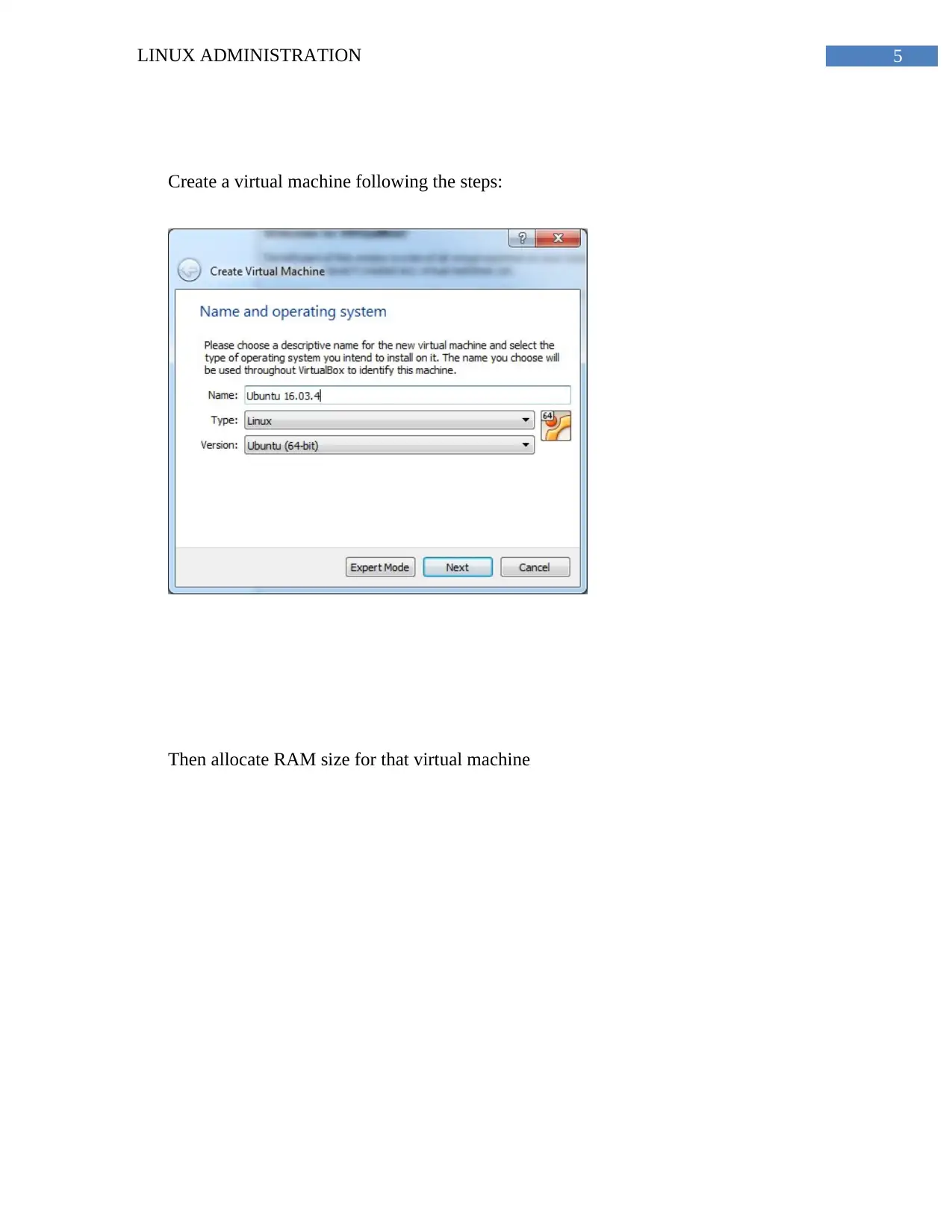
5LINUX ADMINISTRATION
Create a virtual machine following the steps:
Then allocate RAM size for that virtual machine
Create a virtual machine following the steps:
Then allocate RAM size for that virtual machine
⊘ This is a preview!⊘
Do you want full access?
Subscribe today to unlock all pages.

Trusted by 1+ million students worldwide
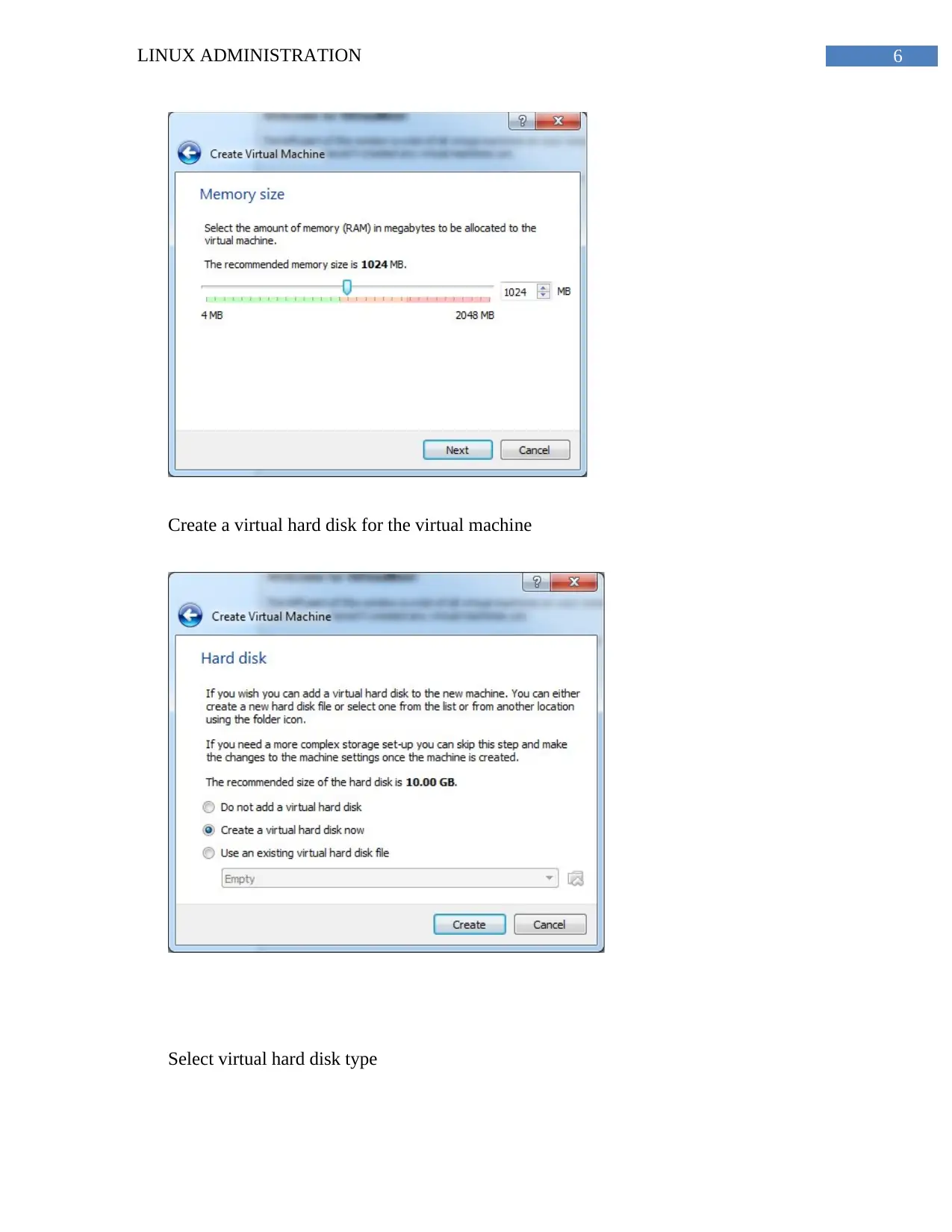
6LINUX ADMINISTRATION
Create a virtual hard disk for the virtual machine
Select virtual hard disk type
Create a virtual hard disk for the virtual machine
Select virtual hard disk type
Paraphrase This Document
Need a fresh take? Get an instant paraphrase of this document with our AI Paraphraser
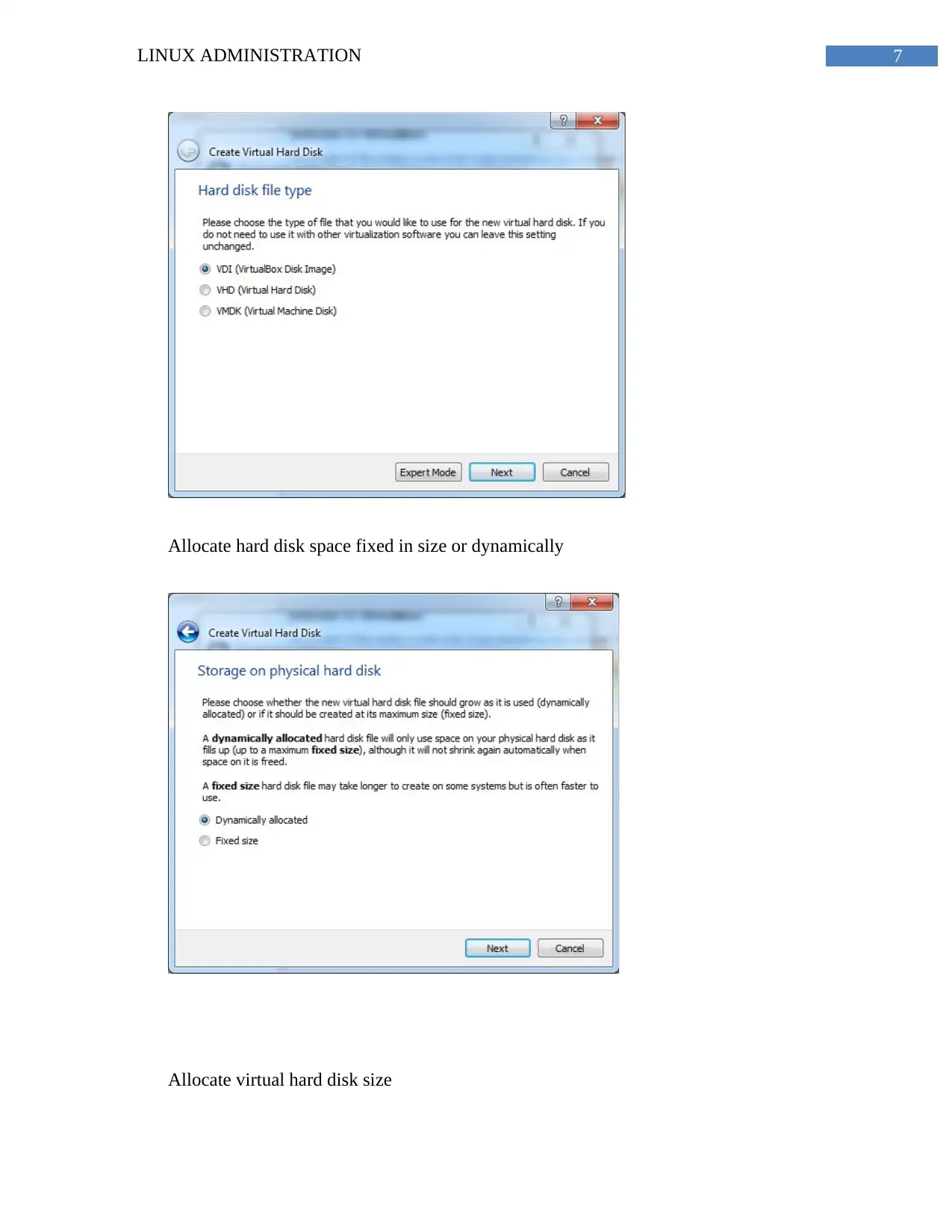
7LINUX ADMINISTRATION
Allocate hard disk space fixed in size or dynamically
Allocate virtual hard disk size
Allocate hard disk space fixed in size or dynamically
Allocate virtual hard disk size
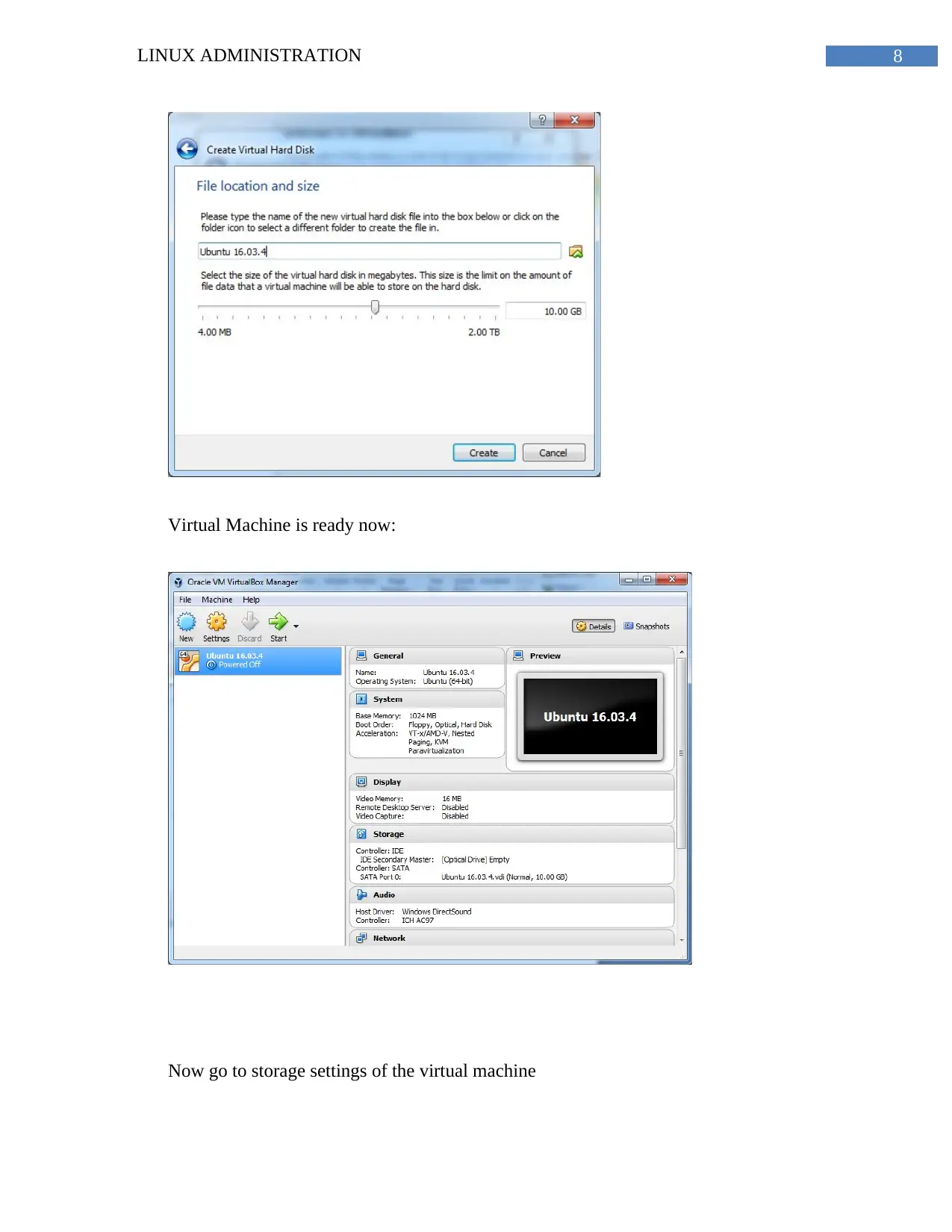
8LINUX ADMINISTRATION
Virtual Machine is ready now:
Now go to storage settings of the virtual machine
Virtual Machine is ready now:
Now go to storage settings of the virtual machine
⊘ This is a preview!⊘
Do you want full access?
Subscribe today to unlock all pages.

Trusted by 1+ million students worldwide
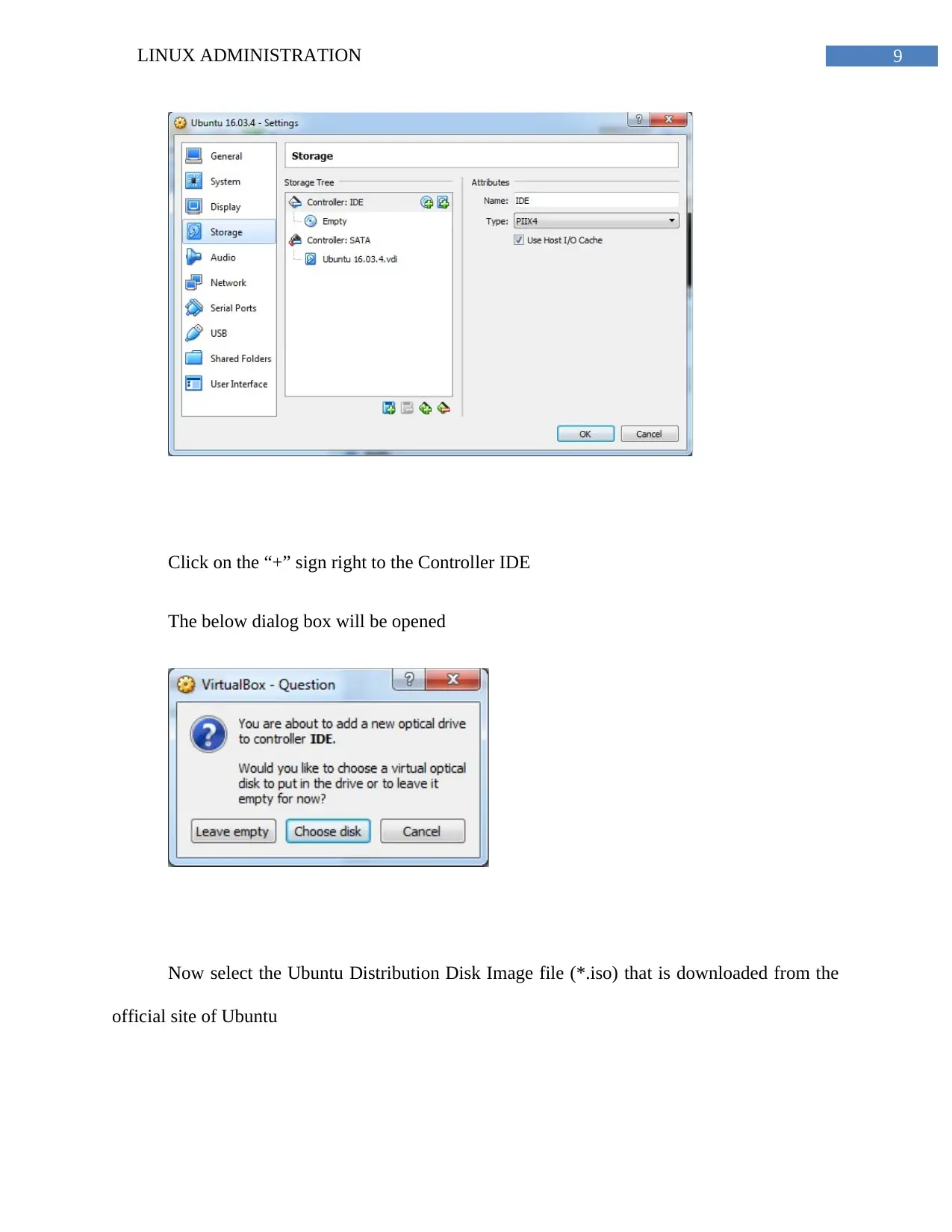
9LINUX ADMINISTRATION
Click on the “+” sign right to the Controller IDE
The below dialog box will be opened
Now select the Ubuntu Distribution Disk Image file (*.iso) that is downloaded from the
official site of Ubuntu
Click on the “+” sign right to the Controller IDE
The below dialog box will be opened
Now select the Ubuntu Distribution Disk Image file (*.iso) that is downloaded from the
official site of Ubuntu
Paraphrase This Document
Need a fresh take? Get an instant paraphrase of this document with our AI Paraphraser
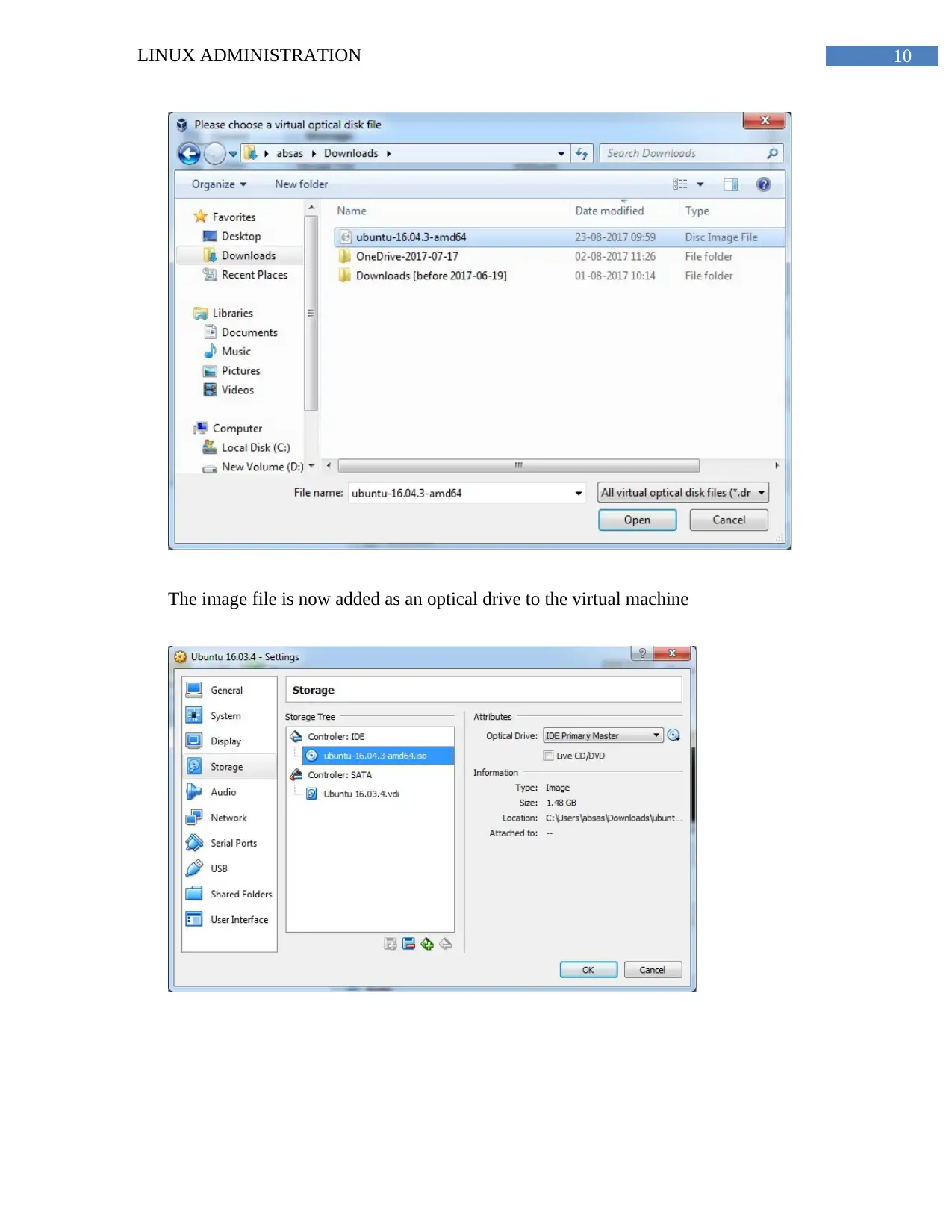
10LINUX ADMINISTRATION
The image file is now added as an optical drive to the virtual machine
The image file is now added as an optical drive to the virtual machine
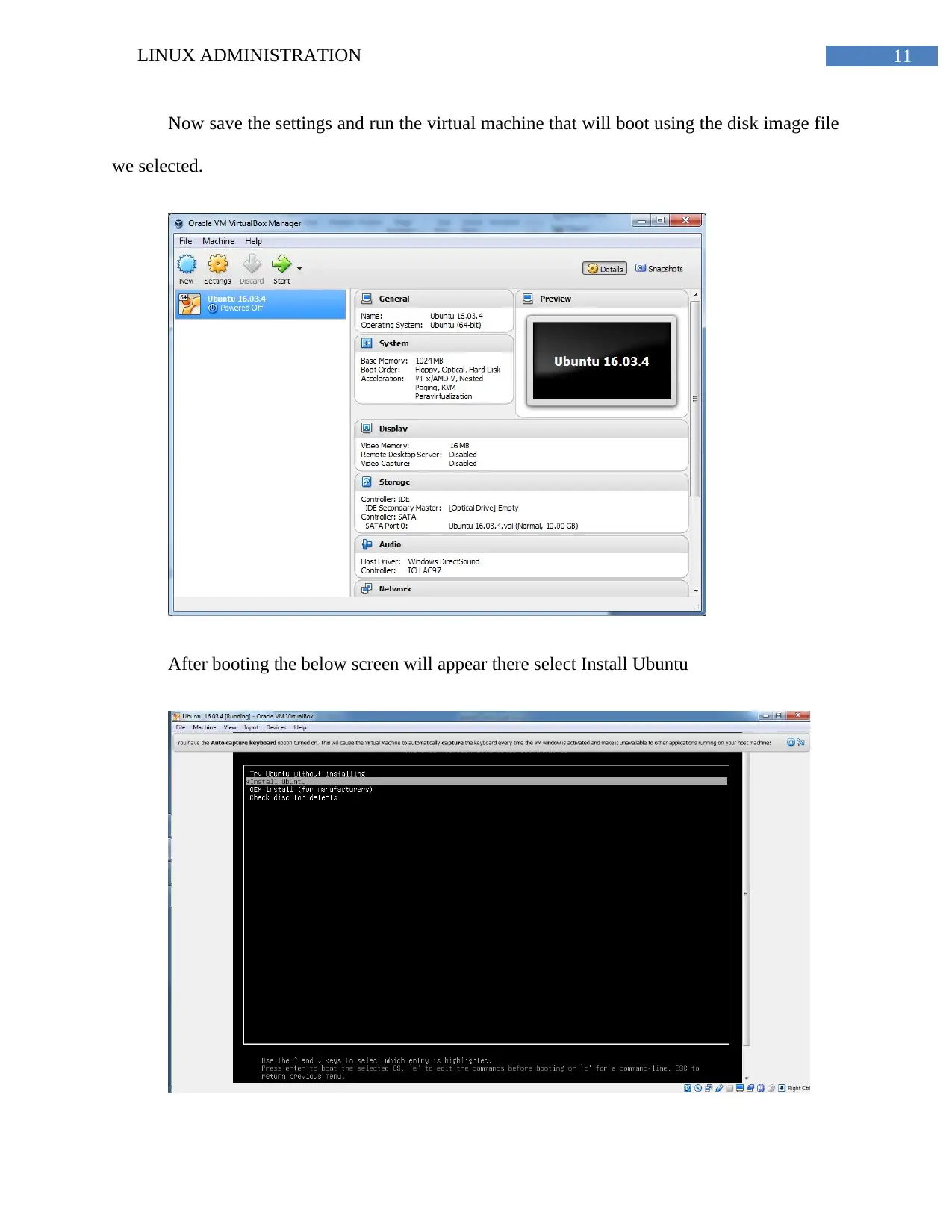
11LINUX ADMINISTRATION
Now save the settings and run the virtual machine that will boot using the disk image file
we selected.
After booting the below screen will appear there select Install Ubuntu
Now save the settings and run the virtual machine that will boot using the disk image file
we selected.
After booting the below screen will appear there select Install Ubuntu
⊘ This is a preview!⊘
Do you want full access?
Subscribe today to unlock all pages.

Trusted by 1+ million students worldwide
1 out of 25
Related Documents
Your All-in-One AI-Powered Toolkit for Academic Success.
+13062052269
info@desklib.com
Available 24*7 on WhatsApp / Email
![[object Object]](/_next/static/media/star-bottom.7253800d.svg)
Unlock your academic potential
Copyright © 2020–2025 A2Z Services. All Rights Reserved. Developed and managed by ZUCOL.




